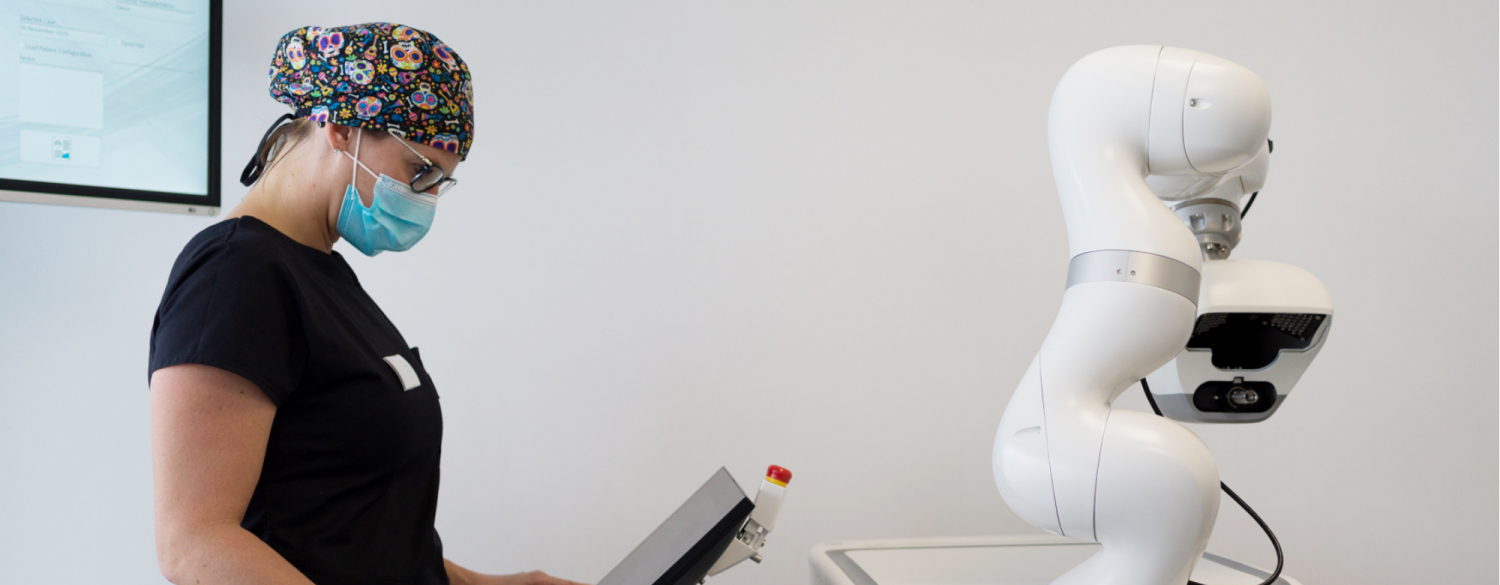ARTAS robotic FUE


FUE Hair Transplant
ARTAS robotic FUE
FUE hair transplantation is an innovative and modern technique that allows hair follicles to be removed from the back of the head or from the temples and reimplanted on bald areas affected by alopecia.
Manually, the results are optimal, definitive and very aesthetic.
In recent years, science and technology have evolved at great speed. And this includes even hair.
Indeed, a new technique is practiced within our NHT Europe centre in Avignon: the ARTAS robotic FUE hair transplant. No scarring, (harvesting principles are identical to other FUE processes) optimal discretion, unparalleled speed and efficiency. Discover this new innovative technique.
What is an Artas robotic FUE hair transplant? Why should this technique be chosen? What is your first consultation for a robotic FUE hair transplant like? What are the different stages of a robotic hair transplant? What results can be expected? What are the advantages? What post-operative consequences should be considered?
In this article, we invite you to learn more about the Artas robotic FUE hair transplant. We give you access to a number of elements to help you make a free and informed choice.

What is an ARTAS robotic FUE hair transplant?
Artas robotic technology is unique in the world and is a real innovation in the field of hair restoration. Alopecia, which affects a large number of people today, both men and women, can be treated with this new technology. The results are natural and definitive, Artas allows a simple, effective, and almost painless procedure.
The robot analyses the path of the hair by studying the difference in contrast between the hair and the skin; for the digital image to be clear, thick dark hair is needed; the greater the contrast (dark hair), the thicker the hair, the sharper the signal and the analysis becomes faster and more precise.
The ARTAS Robot locates and targets the best grafts to harvest because it is equipped with a high-definition stereoscopic vision system that allows it to identify the bulb of the hair and not just the outer part. Thanks to this, the robot targets the most efficient grafts for an optimal result. It can also harvest only follicular units with a certain number of hairs.
Why undergo an ARTAS robotic FUE hair transplant?
Androgenic alopecia is the most common type of baldness. Artas robot technology can treat the different stages of this pathology, whether you are a man or a woman. There have been several successive versions since its introduction in Europe in 2013, and the latest version IX is much more efficient.
The robot has a very fast operating speed making it possible to harvest up to 1500 grafts per hour and thus to practice a single "big session" of 3000 grafts. However, this rate is now the same for motorized FUEs, in experienced centres.
Thanks to this revolutionary technology, the doctor can treat large areas that until recently required several sessions of manual FUE or the practice of the FUT method (strips). This FUT technique is less practiced today because it leaves a transverse scar on the back part of the head; we no longer perform this technique at our centre.
How does the first consultation for a robotic FUE hair transplant take place?
When you come for the first consultation, your surgeon will test the different procedure options with you. Artas Hair Studio software allows a 3D simulation of the hair transplant, but the most important thing to analyse is the thickness and colour of the hair because the robot's scanner analyses the path of the hair by differentiating contrast between skin and hair. in other words, the analysis is easier if the hair is thick, and the hair is dark (a preliminary dyeing may be necessary for people with light hair).
The Artas Hair Studio tool also takes into account the length and colour of the hair, which gives a very realistic simulation and as close as possible to the results expected for the session. Following this simulation, your surgeon establishes with you a transplant plan for the operation.
However, we prefer to show concrete results of our procedures rather than computer simulations.
What are the different stages of an ARTAS robotic FUE hair transplant?

This procedure, although revolutionary, is performed on an outpatient basis. The Artas robot safely and precisely harvests many grafts, and the risk of damaging the hair bulbs is very low. The only downside to the Artas procedure is that the donor area must be shaved in order to better target and harvest the follicular units. It is also a bit time-consuming to install and more expensive due to the essential use of a single-use kit.
The procedure takes place in four stages:
- Selection and dissection of follicular units using the Artas Robot
- Microscopic verification of all grafts
- Preparation of the recipient area by robotic assistance
- Manual reimplantation of hair transplants
The first step is to select and collect follicular units.
Using a very precise scanner, the robot studies the donor area, located at the back of the head. The choice of this area is important because it is not subject to natural hair loss. The Artas robot identifies the best quality hair bulbs in order to optimize the results of the transplant. It allows us to select, if necessary, grafts of 1,2,3, or 4 hairs.
Artas robotic technology cuts the grafts automatically. These are extracted from the scalp manually using micro-tweezers.
Finally, they are checked under a microscope and sorted to ensure optimal results. Before the grafts are reimplanted, they are placed in a saline solution at low temperature, in order to preserve them.
The second step is checking and sorting the grafts under a microscope to ensure optimal results.
Before being reimplanted, the grafts are placed in a saline solution between 2 and 6 degrees Celsius in order to preserve them.
The rate of transection (graft lesion) is around 5% which is very low and corresponds to the rate of the best medical teams, but in our centre the average transection rate over the year is less than 2%, whatever the technique used; this particularly low rate is the average of all our operations over a year and all our operations include this verification under the microscope of the harvested grafts, which is far from common.
The third step consists of possibly preparing the recipient area by robotic assistance.
Small incisions are made using the Artas robot, these will be used to deposit the grafts taken previously. These incisions are determined by the surgeon with a digital treatment plan.
The distance between each incision and the orientation are programmed on the computer.
This step can be avoided by adopting a technique using "sharp implanters", in other words instruments which at the same time perform the skin incision and the deposit of the graft at the same time. The implantation can be either manual or robotic; however, for the frontotemporal region and the vertex, improvements need to be made to the robotic technique, due to the particular hair orientation in these regions.
The fourth step is to reimplant the grafts.
This can be done in several ways:
- The robot can reimplant the grafts without making prior skin incisions, as described above.
- The grafts are placed in the incisions made by the robot, using forceps or dull implanters (not sharp ones).
- Or the robot does not intervene in this step and the surgeon reimplants the grafts using sharp implanters which at the same time make the incision of the skin and deposit the graft.
From the third month, you will see the results appear. The hair starts to grow back from the fourth month, and the density will be more and more visible in 4 to 6 months.
What are the special features of an ARTAS robotic FUE hair transplant?
The advantages of an ARTAS robotic FUE hair transplant are numerous:
- Scars are invisible like any FUE procedure.
- Fast harvesting speed.
- Allows up to 2,500 to 3,000 grafts to be harvested in a single session,
- The choice of grafts of 1, 2, 3 or 4 hairs is possible, as is the distance between each harvested graft, which helps to preserve donor area density.
- Thanks to the precision and accuracy of ARTAS, harvesting angle and depth of are optimal.
- The operation is performed on an outpatient basis: short healing time, no incision, no stitches, no hospitalization.
- The result is definitive and natural over the entire implantation area.
- The donor area is preserved in anticipation of a new procedure, if one is necessary.
What are the postoperative consequences of an ARTAS robotic FUE hair transplant?
Being performed on an outpatient basis, the return to social life is quick (a few days) following the procedure. The donor area is almost invisible after a few days, and you can resume your professional and personal activities quickly.
The recipient area requires careful care for ten days, but the unsightly consequences of oedema and scabs remain very limited. Tiny lesions on the donor area heal in less than two days and are completely invisible even if you wear your hair very short.
The essential information
- Avant-garde technique
- Significant improvement in the harvesting quality with version IX. Technology performs better with dark and thick hair.
- Can work for frizzy hair (Afro hair)
- Implantation quality to be improved upon
- More expensive technique linked to the use of single-use kits (€ 1,300 for harvesting)
ARTAS ROBOT FEATURES
ARTAS IX Evolution

Impact on hair restoration / implantation
- Optimizes the graft harvest area, incision and implantation
- Recognizes and learns new situations in order to constantly improve
- Memorizes information, creates a new parameter map based on the location on the scalp
- Great adaptability
ARTAS IX Features
- Simultaneous harvesting, incision and implantation
- New stereoscopic vision system with 3 cameras
- New clinical workflow reduces procedure time
- 7-axis robotic arm
- Electronic signature
- Built with a motorized mechanism
- Silent mechanism
Our centre is the first equipped with ARTAS IX in Europe.
The analysis of the first interventions suggests very good results because the graft quality is markedly improved.
This robot also makes it possible to implant grafts while avoiding existing hair (so no hair loss).
It’s cost of use has also decreased a little, which will allow more patients to benefit from it.
Smaller, quieter, faster, more manoeuvrable with an arm with 7 joints allowing great freedom of spatial orientation, this robot is a major asset in a hair transplant centre.
Until now in certain situations motorized harvesting with hybrid punches allowed experienced operators to harvest better grafts than the robot (previous versions).
Today, robotic harvesting makes it possible to harvest high quality grafts, and above all, it is constantly improved; the IX robot now performs the graft implantation, avoiding the healthy hair still present on the head. Patient comfort has also undergone changes allowing for larger procedures.
How Artas has perfected hair transplantation
- Visualization of the position and orientation of each graft
- Monitors the position and orientation of each hair 60 times per second
- Recognizes and identifies characteristics and adapts to patient movements
- Superior vision = Superior harvesting precision natural-looking implantations

Artas “Hair Studio” software
- interactive 3D tool transforming patient consultations
- 3D simulated hair transplant using real patient photographs
- helps visualize patient expectations
 Manuel VS Artas IX
Manuel VS Artas IX

ARTAS IX implantation
Setting out markers delimiting the implantation area and / or making of incisions receiving the grafts.
TYPE OF ANESTHESIA: local
AVERAGE DURATION OF THE PROCEDURE: it depends on the number of grafts (maximum 3000 grafts per day)
DONOR AREA: occipital, parietal or temporal
SHAVING LENGTH: 1 mm
RESUMPTION OF SOCIAL ACTIVITY: 10 days
RESUMPTION OF SPORTING ACTIVITY: after 10 days
NHT EUROPE


